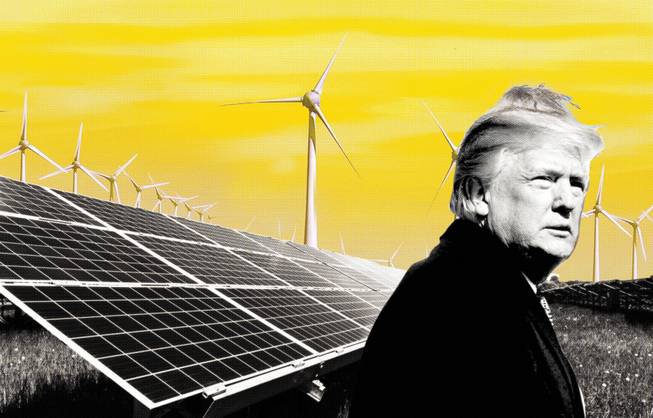
Photo illustration / AP photos
Friday, Feb. 23, 2018 | 2 a.m.
On the morning after his State of the Union address, in which President Donald Trump told the nation that his administration had “ended the war on American energy,” he made news that suggested otherwise.
Citing draft budget documents it obtained from the White House, The Washington Post reported that the Trump administration was proposing to cut federal funding for renewable energy research and development by 72 percent.
“This couldn’t have been worse for this state,” said Robert Lang, an economic development expert and executive director of Brookings Mountain West, during a panel discussion examining the State of the Union address. “This is an actual assault on something that was one of the state’s largest job producers, one of the gainers in our economy, one of our points of pride.”
Trump’s reductions would be imposed on the Energy Department’s Office of Energy Efficiency and Renewable Energy, which receives about $2 billion. When the White House’s formal budget proposal came out Feb. 12, it included a cut that was less deep than one in the draft budget, but only slightly. It reduced funding about 65 percent — offering $696 million for the office, which researches solar power, electric vehicles and an array of other clean energy technologies.
“Nevada is at the forefront of America’s clean energy economy. The Trump administration’s budget threatens that leadership, it threatens Nevada jobs and it puts the interests of Big Oil above the well-being of workers in Nevada,” said Sen. Catherine Cortez Masto, D-Nev., in a statement following the release of Trump’s formal budget. “In Nevada, we have the opportunity to convert closed mines into renewable energy projects that keep our rural economies growing, attract new jobs and investment to our state, and lead the way in sectors from solar to geothermal energy. I will oppose any attempt to weaken Nevada’s economy, and that is exactly what this budget proposes to do.”
Lang said the proposed cuts, along with tariffs imposed by the Trump administration on imported solar panels, threatened to slow the development of Nevada’s renewable energy industry and in turn would force the state to continue relying on imported energy sources like natural gas. Because energy creates wealth in the areas where it’s generated as opposed to where it’s consumed, he said, the changes could hurt Nevada’s economy.
“In Nevada, we’re a post-carbon energy producer,” Lang said. “We don’t have oil or natural gas. So anything that either imposes tariffs … or anything that reduces public investment in the [research and development] that would advance this kind of technology is against Nevada’s interests.”
Nevada Assemblyman Chris Brooks, D-Las Vegas, agreed, and added that the cuts in research funding could be felt directly in Southern Nevada.
“Some of that money comes directly to UNLV, so we’ll feel immediate budget constraints at UNLV, at Desert Research Institute, at the University of Nevada-Reno,” he said during the panel discussion.
Rebecca Wagner, a former member of the Nevada Public Utilities Commission who now operates an energy consulting firm, said the cuts also would likely affect policymakers. The reason: They threaten to reduce output from the National Renewable Energy Laboratory and similar state-level operations, which produce information that legislators, regulators and others use in establishing policies.
“To see funding cuts of that magnitude, I’m an optimist, so I’d like to say, ‘Wow, renewables must be doing so well that they don’t need that funding,’ ” said Wagner, who also participated in the panel presentation. “But we need that funding. It’s critical to maintain the trajectory that we’re on.”
Brooks and Lang said the U.S. at one time was a leader in developing renewable energy technology, but since has lost its edge. Reducing federal funding would allow other nations to increase their lead, they said.
“Nations that just years ago we would have looked at and said, ‘They’ll never be able to catch up with the United States,’ have surpassed us,” Brooks said. “And they’re doubling down on their research and development. We’re being passed up by China and Europe, where we used to be the leaders on some of this technology. And that’s very disappointing.”
While reducing funding for renewables, Trump’s new budget calls for an increase of about 19 percent for the fossil energy research and development office. The budget for those operations: $502 million.
According to the U.S. Energy Information Administration, about 88 percent of the energy consumed in Nevada comes from other states. In 2016, the last full year for which statistics were available, Nevada generated 21.6 percent of its electrical power through renewable sources, including geothermal, solar, wind and hydroelectric.
Geothermal produced the most among those resources, with 44 percent of the production coming from renewables. The state ranked No. 2 in the nation in utility-scale generation from geothermal and No. 4 in solar energy, the USEIA reported.
A report from the nonpartisan business group E2 (Environmental Entrepreneurs) and the Las Vegas-based Clean Energy Project said 31,000 people worked in Nevada’s clean energy economy last year.
This story originally appeared in the Las Vegas Weekly.
